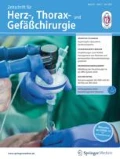Zusammenfassung
Die transmyokardiale Laserrevaskularisation (TMLR) wird bei Patienten mit schwerer, diffuser, sklerosierender 3-Gefäß-KHK angewendet, die unter maximaler medikamentöser Therapie stehen und keine Kandidaten für eine Katheterintervention (PTCA mit oder ohne Stentimplantation), aortokoronare Bypassoperation oder Herztransplantation sind. Jedoch profitieren nur 65–70% der Patienten von der TMLR. Aus diesem Grund untersuchten wir an 20 präoperativ bekannten Faktoren den Einfluss auf den Benefit nach TMLR. Wir führten eine logistische Regressionsanalyse bei 134 Patienten durch, die an unserer Institution von November 1994 bis April 2001 einer isolierten TMLR unterzogen wurden.
Responder und Non-Responder unterschieden sich signifikant voneinander in Bezug auf die Inzidenz eines Diabetes mellitus. Patienten mit Diabetes mellitus hatten nur eine Chance von 43% von der TMLR zu profitieren im Vergleich zu Patienten ohne Diabetes mellitus (odds ratio=0,43 [0,20–0,92]). Weiterhin bestand bei Patienten mit einem Body mass Index >25 ein ca. dreifach erhöhtes Risiko im ersten postoperativen Jahr nach TMLR zu versterben im Vergleich zu Patienten mit einem Body mass Index von 25 oder größer (odds ratio=2,97 [1,05–8,40]). Bei der 1-Jahres-Überlebenswahrscheinlichkeit hatte die Inzidenz eines Diabetes mellitus einen tendenziellen, aber soeben nicht signifikanten Einfluss (p=0,058).
Aufgrund dieser Daten sind wir zurückhaltender geworden, Patienten mit Diabetes mellitus einer TMLR zu unterziehen.
Summary
Transmyocardial laser revascularization (TMR) has been used during the last years for patients with diffuse coronary artery disease. These patients take antianginal drugs and are not candidates for percutaneous transluminal coronary angioplasty, bypass grafting or heart transplantation. But only 65–70% of the patients profit from TMR. We performed an univariate logistic regressions analysis of 20 factors on the benefits and outcomes after TMR. We analysed 134 patients who were operated by isolated TMR at our institution between November 1994 and April 2001. Responder and non-responder differed significantly to the incidence of diabetes mellitus. The chance of profiting from TMR was for patients with diabetes mellitus only 43% compared to patients without diabetes mellitus (odds ratio=0.43 [0.20–0.92]). Patients with a preoperative body mass index less than 25 had a threefold increase in the chance of death during the first year after TMR compared to patients with a body mass index of 25 or more (odds ratio=2.97 [1.05–8.40]). Also the incidence of diabetes mellitus was slightly but not significantly different between 1-years survivors and non-survivors (p=0.058). Now we recommend caution in selecting TMR to diabetic patients.
Author information
Authors and Affiliations
Additional information
Eingegangen: 10. Dezember 2002 Akzeptiert: 6. Januar 2003
Correspondence to R. Petzina
Rights and permissions
About this article
Cite this article
Petzina, R., Krabatsch, T., Günther, G. et al. Prädiktoren eines Benefits nach transmyokardialer Laserrevaskularisation. Z Herz-, Thorax-, Gefäßchir 17, 17–23 (2003). https://doi.org/10.1007/s00398-003-0377-1
Issue Date:
DOI: https://doi.org/10.1007/s00398-003-0377-1

